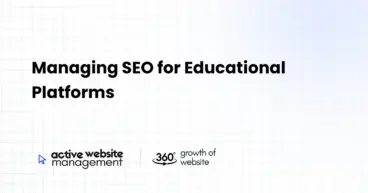January 9, 2025
11 min read
The Secret Sauce: Why SEO is Non-Negotiable for Beauty & Salon Businesses
Imagine walking into a bustling city center. You’re looking for a specific salon – maybe one that specializes in balayage, or a place known for amazing facials. You wouldn’t wander aimlessly, would you? You’d likely pull out your phone and search. That’s exactly what your potential clients are doing. Search Engine Optimization (SEO) is the powerful tool that ensures your salon pops up when they do. It’s not just about being visible; it’s about being found by the right people, at the right time, when they’re ready to book.
Why is Local Beauty SEO Crucial?
The beauty and salon industry thrives on local clientele. People aren’t likely to travel across state lines for a haircut; they want a trusted, convenient option nearby. Local SEO, a specialized arm of SEO, focuses on ranking your website higher in search results within your geographic area. This means:
- Attracting Local Customers: Reaching clients in your immediate vicinity who are actively looking for services like yours.
- Building Community: Establishing your salon as a go-to destination within your neighborhood.
- Higher Conversion Rates: Local searches often indicate a higher intent to book, meaning more appointments and more revenue.
More Than Just Visibility: The Tangible Benefits of Strong SEO
Beyond simply being found, a well-optimized website can:
- Increase Bookings: Drive more appointments directly through your website.
- Establish Authority: Position your salon as a leader in the industry.
- Build Trust and Credibility: A high-ranking website signals legitimacy and quality.
- Boost Brand Awareness: Make your salon a recognizable name within the local community.
- Save on Marketing Costs: Compared to traditional advertising, SEO provides a longer-term return on investment.
The Foundation: On-Page Optimization for Beauty & Salon Websites
On-page optimization refers to the changes you make directly on your website to improve its search engine ranking. It’s the fundamental work you do to ensure search engines understand what your site is about and find it relevant to user queries.
Don’t Just Maintain Your Website—
Grow It using Active Website Management! Don't Wait for Growth—Accelerate It with Active Website Management
Keyword Research: The Cornerstone of Successful SEO
Before you start tweaking your website, you need to understand what words your potential clients are actually using when they search. This is where keyword research comes in.
- Brainstorming: Begin with a simple list of relevant terms: “hair salon near me,” “best facial [your city],” “manicure prices,” “wedding hair styles,” “organic hair color.” Don’t limit yourself – think like a client!
- Utilizing Keyword Tools: Use tools like Google Keyword Planner, SEMrush, or Ahrefs to discover related keywords, their search volumes, and competition levels.
- Long-Tail Keywords: Don’t forget the power of long-tail keywords – longer, more specific phrases. For example, instead of “hair salon,” try “best curly hair salon downtown.” These usually have lower competition and high conversion rates.
- Local Keywords: Add location modifiers to your main keywords: “[your city] hair salon,” “best [your neighborhood] spa,” “[your county] makeup artist.”
Title Tags & Meta Descriptions: The First Impression
These are the snippets of text that appear in search results, and they are crucial for attracting clicks.
- Title Tags: These should be concise, compelling, and contain your main keyword. Keep them under 60 characters to avoid being cut off in search results. Example: “Luxury Hair Salon | Balayage & Color Specialists in [Your City]”.
- Meta Descriptions: Provide a brief summary of the page’s content, enticing users to click. Include your main keyword and a clear call-to-action, like “Book Now!” Aim for under 160 characters. Example: “Experience the best hair coloring services in [Your City]. Book your appointment online today!”
Header Tags (H1, H2, H3): Structuring Your Content
Header tags organize your content, making it easy for search engines and users to navigate.
- H1 Tag: Use only one H1 tag per page. It should include the page’s primary keyword and should be highly relevant to the page’s content. Example: “Professional Hair Salon Services in [Your City]”.
- H2 & H3 Tags: Use H2 tags for main sections and H3 tags for subsections. Incorporate relevant keywords throughout but keep them natural and readable. Example H2 tags: “Expert Haircuts & Styling”, “Relaxing Facial Treatments”, “Bridal Hair & Makeup Packages.”
Content Optimization: The Heart of Your Website
High-quality, informative, and engaging content is critical for both users and search engines.
- Service Pages: Each service should have a dedicated page with detailed descriptions, benefits, and pricing. Include relevant keywords naturally throughout the text.
- About Us Page: Tell your story, highlighting your salon’s unique selling proposition (USP). Showcase your team’s expertise and passion.
- Blog: Regularly publish blog posts on topics relevant to the beauty industry and your audience’s interests. This helps attract more traffic and establish your salon as an authority. Example blog topics: “How to Choose the Perfect Hairstyle for Your Face Shape,” “The Benefits of a Professional Facial,” “Trending Makeup Looks for 2024.”
- Use Visuals: High-quality images and videos are essential. They not only enhance user engagement but also allow you to utilize alt tags (descriptive text for images) with relevant keywords.
- Natural Keyword Integration: Avoid “keyword stuffing.” Write for your audience first, naturally integrating relevant keywords into your content. The key is readability and authenticity.
Internal Linking: Connecting the Pieces
Internal linking connects your pages and helps search engines understand your website’s structure.
- Link Strategically: Link relevant pages to each other throughout your content. This encourages users to explore more of your site and signals relevance to search engines. Example: on your “Haircut” service page, link to your “Stylists” page or a relevant blog post on “Trending Hairstyles.”
- Anchor Text: Use keyword-rich anchor text (the clickable text within a link) to tell search engines what the linked page is about. Instead of “click here,” use “Book a Haircut Appointment.”
Mobile Optimization: Crucial in the Modern Era
A significant portion of online searches come from mobile devices.
- Responsive Design: Ensure your website is responsive, meaning it automatically adjusts to fit different screen sizes. This ensures a seamless user experience on all devices.
- Fast Loading Speed: Optimize your website for speed. Slow-loading sites are penalized by search engines and frustrate users.
- Touch-Friendly: Make sure buttons and links are easy to tap on a touchscreen.
Off-Page Optimization: Building Your Online Reputation
Off-page optimization refers to activities you perform outside of your website to improve its search engine rankings. This is about building your online presence and reputation.
Local Citations: Getting Listed in the Right Places
Local citations are mentions of your business’s name, address, and phone number (NAP) on other websites.
- NAP Consistency: Ensure your NAP information is consistent across all online platforms. Inconsistent information can confuse search engines and hurt your rankings.
- Business Directories: List your salon on reputable online directories like Google My Business (now Google Business Profile), Yelp, Bing Places, Facebook, and industry-specific directories.
- Claim Your Listings: If your business is already listed on a directory, claim and verify it to ensure the accuracy of the information.
Link Building: Earning Trust and Authority
Earning backlinks (links from other websites to yours) is a powerful signal to search engines that your website is valuable and trustworthy.
- Guest Blogging: Contribute guest posts to other beauty and lifestyle blogs, linking back to your website.
- Local Partnerships: Collaborate with other local businesses and organizations, linking to each other’s websites.
- Community Engagement: Sponsor local events and get your salon mentioned on community websites.
- High-Quality Content: The best way to earn backlinks is to create high-quality content that other websites want to link to.
Don't Wait for Growth—Accelerate It with
Active Website Management Don't Wait for Growth—Accelerate It with Active Website Management
Social Media Optimization: Expanding Your Reach
Social media plays a vital role in driving traffic to your website and enhancing your brand’s visibility.
- Platform Choice: Select the platforms that align best with your target audience. Instagram is particularly popular for visual industries like beauty.
- Engaging Content: Create engaging content that resonates with your audience. This could be photos of your work, client testimonials, behind-the-scenes glimpses, and salon updates.
- Promote Your Website: Include links to your website in your social media bios and posts.
- Social Sharing Buttons: Add social sharing buttons to your website so that visitors can easily share your content.
Online Reviews: Building Social Proof
Online reviews are essential for building trust and attracting new customers.
- Encourage Reviews: Prompt your satisfied clients to leave reviews on platforms like Google and Yelp.
- Respond to Reviews: Actively respond to both positive and negative reviews in a professional and helpful manner.
- Manage Your Reputation: Address negative reviews promptly and try to resolve any issues.
Technical SEO: The Hidden Engine of Your Website
Technical SEO refers to the backend optimizations that ensure your website is crawlable, indexable, and user-friendly for search engines.
Website Speed: Keeping Users Engaged
A slow-loading website can frustrate users and negatively impact your search rankings.
- Image Optimization: Compress your images without sacrificing quality. Use the right file formats (JPEG for photos, PNG for graphics).
- Caching: Implement browser caching to store static files, enabling faster loading times for returning visitors.
- Code Optimization: Minify your CSS, JavaScript, and HTML code.
XML Sitemap: Helping Search Engines Find Your Pages
An XML sitemap lists all of your website’s pages, making it easier for search engines to discover and index your content.
- Create a Sitemap: Generate an XML sitemap using a tool or plugin and submit it to Google Search Console.
- Update Regularly: Regularly update your sitemap when you add or remove pages.
Robots.txt File: Controlling Search Engine Crawlers
The robots.txt file tells search engine crawlers which pages on your site they are allowed to crawl.
- Block Unnecessary Pages: Block search engines from crawling pages that are not relevant to users, such as admin pages.
SSL Certificate (HTTPS): Ensuring Secure Connections
An SSL certificate ensures that data transmitted between your website and users’ browsers is encrypted.
- Secure Your Website: Install an SSL certificate on your website to show users that their information is safe.
Active Website Management: Your Partner in SEO Success
Maintaining a website and optimizing it for search engines requires consistent effort. Active Website Management can be your reliable partner in this process.
What is Active Website Management?
Active Website Management provides ongoing website care and maintenance, encompassing:
- Regular Updates: Keeping your website’s software and plugins up to date to prevent security vulnerabilities.
- Performance Monitoring: Tracking your website’s speed and performance to identify areas for improvement.
- Security Scans: Ensuring your website is secure from malware and hacking attempts.
- SEO Monitoring: Tracking your SEO performance and implementing strategies for improvement.
- Content Updates: Keeping your website fresh and engaging with new content.
- Technical Support: Providing ongoing technical support to ensure your website is functioning smoothly.
Why Choose Active Website Management?
- Expertise: Access a team of professionals with deep knowledge of website management and SEO.
- Time Savings: Free up your time to focus on running your business.
- Improved Results: Benefit from proactive and data-driven strategies.
- Peace of Mind: Know that your website is in capable hands.
- Custom Solutions: Tailored solutions to meet the unique needs of your salon.
How Active Website Management Can Help Your Salon
With Active Website Management, you can:
- Achieve Higher Search Rankings: Improve your website’s SEO performance and attract more local clients.
- Boost Website Traffic: Increase the number of visitors to your website.
- Increase Bookings: Drive more appointments directly through your website.
- Establish Authority: Position your salon as a leader in the beauty industry.
- Build a Strong Online Presence: Establish a strong foundation for your business online.
Tracking Your Progress: Measuring SEO Success
Measuring your SEO progress is crucial to understanding what’s working and what needs improvement.
Key Performance Indicators (KPIs)
Monitor the following KPIs:
- Organic Traffic: The amount of traffic coming to your website from search engine results.
- Keyword Rankings: The positions your website holds for relevant keywords in search engine results.
- Bounce Rate: The percentage of visitors who leave your website after viewing only one page.
- Time on Page: The average amount of time visitors spend on your pages.
- Conversion Rate: The percentage of visitors who take a desired action, such as booking an appointment.
Google Analytics & Search Console
Use these free tools to track your website’s performance:
- Google Analytics: Tracks website traffic, user behavior, and conversions.
- Google Search Console: Provides insights into your website’s search engine visibility and technical issues.
Regular Reporting
Generate regular reports to track your progress and identify areas for improvement. Analyze your data and adjust your SEO strategies as needed.
The Long-Term View: Consistency is Key
SEO is not a one-time task; it’s an ongoing process. Consistent effort and regular optimization are key to achieving long-term success. Stay patient, track your progress, and adjust your strategies as needed. With the right approach and a dedicated partner, your beauty or salon business can thrive online.
By implementing these strategies and committing to active website management, your salon can not only be found online but also become the preferred choice for beauty services in your community. This strategic approach is what moves a business from simply existing online to truly dominating their local market. Remember, the online world is your showroom – make it irresistible!







